"TYSKLANDSBRIGADEN"
The Independent Norwegian Brigade Group in Germany
1947-1953
By Maj-General Olav Breidlid (Retd)
In the winter of 1947 Norwegian soldiers left with the troopship "SVALBARD" to participate in the post WWII occupation of Germany. They travelled under the motto "To Germany for peace".
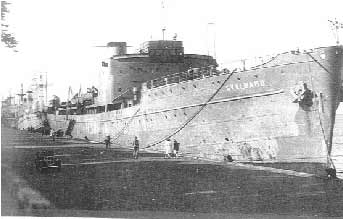
This was the first time that Norway sent military units abroad during peacetime since the dissolution of the union with Sweden in 1905. This participation in Germany lasted for six years up to the spring of 1953, involved approximately 50,000 men and could be said to be the forerunner for later Norwegian international contributions.
The question about Norwegian participation in the occupation of Germany arose in London already during the war. After negotiations with the United Kingdom in the spring of 1946, agreement was reached about stationing a Norwegian force in the UK zone in Germany from march 1947, first for two years with relief every six months. The force would be under British command, in regards to everything which concerned occupation tasks. In the broadest sense this encompassed dissolution of the German military apparatus, running down of the German weapons industry, the arrest of war criminals and removal of Nazis from positions of power. At the same time the occupation forces would, after the destruction of the war, help to rebuild the country and help with the introduction of a democratic system of government in Germany.
The mission of the Norwegian force was to ensure law and order in the assigned area of responsibility. Otherwise the military training was to continue on from the recruitment period in Norway.
The UK's original wish was for a Norwegian force of approximately 12,000 men, but because of economical and personnel restrictions, e.g. in the availability of qualified officers, this was much more than Norway could assist with. Not everyone was in agreement that Norway should participate in Germany at this point in time. Since Norway lay in a military vacuum, both individual politicians and higher military leaders claimed that a military defence should be established at home first. But the leading political opinion was that Norway was morally compelled to say 'yes' to the British request.
The Norwegian parliament decided that participation should be limited to a force of 4,400 officers and men. This however meant that a greater part of the Army's yearly quota of conscripts would have to serve at least half of their conscription period in Germany. Although there was disappointment in the UK over the size of the Norwegian contribution, Norway reached a very favourable agreement with the hire of necessary military material and equipment. In fact it was cheaper to carry out military training in Germany than it was in Norway. Besides, large parts of the material were presented to Norway after the stay in Germany.
The Norwegian contribution was two fold and consisted of an HQ - The Germany Command - ("Tysklandskommandoen") with a staff-, communications-, medical-, welfare- and other key personnel, in all about 200 persons. Most of these personnel were spread around the Norwegian garrisons in Germany. Originally it was meant that 100 women volunteers should be part of the HQ but after a heated debate and great resistance in Norwegian opinion, the Norwegian parliament decided (in December 1946) that all military training of women should cease until the question of female military service was clarified. It would be 30 years before women were allowed to volunteer for military service in Norway.
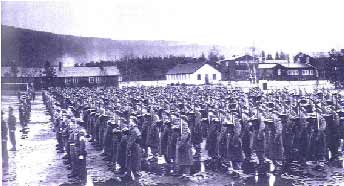
Heistadmoen 1947. Bn 1/Brig 471.
The main force of the Norwegian contribution was a reduced brigade - The Independent Norwegian Brigade Group - ("Tysklandsbrigaden"). The brigade would not be larger than 4200 men, which was 1400 - 1800 men less than such an independent unit would normally consist of. Important parts normal for complete training and independent operations in the field, had to be cut out. For accomplishing the tasks of occupation this was not so important. However, when the Korean War broke out the force was instructed to defend Schleswig-Holstein, the insufficiencies meant reduced battle and survival capabilities in a war situation.
The commanding officer for the HQ had the rank of Major General and was the senior Norwegian officer in Germany. He was the liaison between the Brigade, the Norwegian authorities and the British Military authorities. At the same time he had the overall responsibility for training, administration and jurisdiction in the Norwegian force.
Before travelling to Germany the personnel went through a recruit-training period of 4 or 6 months depending on the length of the conscription service which varied through the years from 10 to 12 months. The units were therefore not completely trained when they were sent on service. Training was continued after arrival in Germany.
The first three brigades - Brig. 471, 472 and 481 (the first two figures are the year and the last is the sequence during the actual year) were stationed in the Harz area south east of Hannover. The terrain here consisted of wooded hills and ridges, and looked somewhat like the eastern parts of Norway. Norwegian garrisons were placed in Braunschweig, Goslar, Northeim, Holzminden, Höxter, Göttingen and Bad Gandersheim. Apart from Braunschweig the Norwegian area of responsibility was not hit hard by the destruction of war. But during the transport movements from Hamburg and south through Germany, the Norwegians got a vivid impression of the destruction of war through out the country.The conditions to have an effective military training in Germany were a lot better than back in Norway. The accommodation was excellent and there was easy access to large shooting ranges and training areas, which were manned by Britons and Germans.
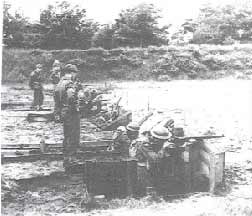
Sennelager.
The conditions to have an effective military training in Germany were a lot better than back in Norway. The accommodation was excellent and there was easy access to large shooting ranges and training areas, which were manned by Britons and Germans.
Combat experienced British instructors took part in this training and there were plenty of supplies from British war surplus stores. Norwegian army training (in peacetime) had hardly been better than it was in Germany.
In the tense political situation, which arose after the communist coup in Checkoslovakia in 1948 and during the blockade of Berlin 1948-1949, the Norwegian units were in the exposed areas bordering the Soviet zone in the Harz hills. The Norwegians, together with the British and Germans, had to take an increased part in border-traffic control. In June of 1948 there was a full alarm in connection with the currency issue in West Germany and the Soviet blockade of Berlin. Norwegian soldiers for the first time risked being involved in an armed conflict between the major powers, this was something which had not be a condition for participation in Germany. The Norwegian authorities wished to move the Brigade away from the border area nearer to an embarkation port, eventually to ship the whole force home. After renewing the agreement with Britain the Norwegian contingent was moved, in the autumn of 1948, to Schleswig-Holstein. Through the years, there were Norwegian garrisons in Itzehoe, Neumünster, Rendsburg, Husum, Holtenau (north of Kiel), Schleswig and Flensburg.
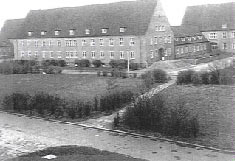
Military barracks in Husum.
However also in the plains around Schleswig-Holstein the Norwegian units were exposed to the Soviet border area east of Lübeck.
In the event of war the original intention was to evacuate the Norwegian units via Denmark and then back to Norway. But after the Korean war broke out in the summer of 1950 the Norwegian government decided that the Brigade together with British and Danish units in the area, about 6500 men, would fight a delaying action back towards the Danish border in the event of a Soviet attack. Since the Norwegian contingent was the largest, the senior Norwegian officer in Germany should have command over the collective allied force. In comparison to the forces on the opposite side of the border, this was a large and difficult mission that was imposed on the Norwegian General.
During the years of 1950 - 1952 a plan was worked out with the Kielcanal as a forward line of defence. All the major bridges, gates and ferry landings in the areas by the canal, Schlei and Eideren were prepared for demolition. An execution of the plan would have resulted in all land communications between Scandinavia and Central Europe being cut.
To be best prepared and trained for this difficult mission the brigade manoeuvres, which earlier had been run in the training areas further south, were, from 1952, carried out in the Schleswig-Holstein area.
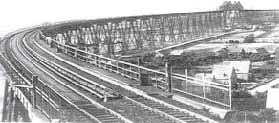
The "Hochbrücke" in Rendsburg.
The Germany Command (TK), which originally consisted only of administrative personnel, was reinforced in 1952- 53 with operations and command personnel. This part of the TK was named the 6th Division Command and was later retained in Northern Norway.
The personnel in the Brigades had lived through all the unpleasantness of the war and the German occupation. How would they react to the German population after they arrived in Germany? There was no clear Norwegian directive about how they should relate to the German population. The British decisions in this area were also valid for the Norwegians. The Norwegian slogan was that the personnel were to be proper, reserved and with minimal contact with the Germans. However no direct prohibition was enforced.

Under NATO-command. General Eisenhower inspecting Norwegian troops in Germany.
The impressions from the wretched conditions in Germany those first years gave little thought for retaliation and revenge. In practice it was impossible to hinder contact between the Norwegians and Germans, especially members of the opposite sex.Through the years there were many firm contacts made between the Germans and Norwegians. The big picture is that the Norwegian military presence in Germany during these six years assisted in normalising relations between the two countries in this post-war period.

German children celebrating Christmas in a Norwegian garrison.
For the Norwegian youth, which had been confined to Norway for five years, the leave periods travelling around in Germany and to other countries like the Netherlands, Belgium, France, Austria, Italy and not to forget Denmark, were a great experience. The impressions that were taken home and spread through out the country have possibly helped to influence the populations positive attitude to later military involvement in the United Nations (UN) and NATO.
In the April of 1953 the Norwegian participation in the occupation and defence of West Germany was wound down in the favour of the build up of the Norwegian domestic defence with priority going to Northern Norway.
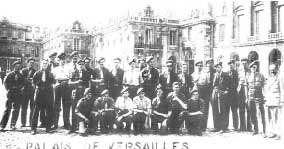
Norwegian personel on leave at Versailles.
Both for the level of quality that the Norwegian army has reached and the good military co-operation, which is established within the NATO alliance, the experiences and knowledge from the time in Germany were undoubtedly of great significance. The veterans from the Norwegian Brigade Groups for many years also formed the main part of the Norwegian mobilisation force.
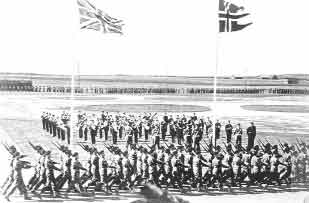
The last Norwegian parade. Schleswig Land April 11th 1953.
REUNION AFTER 47 YEARS
|